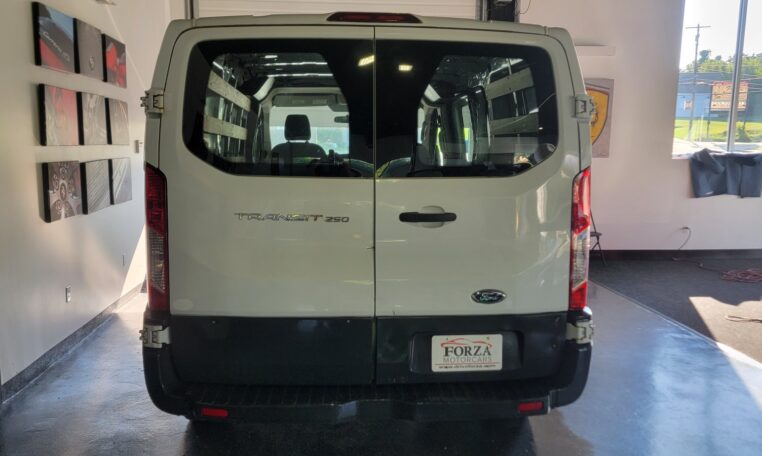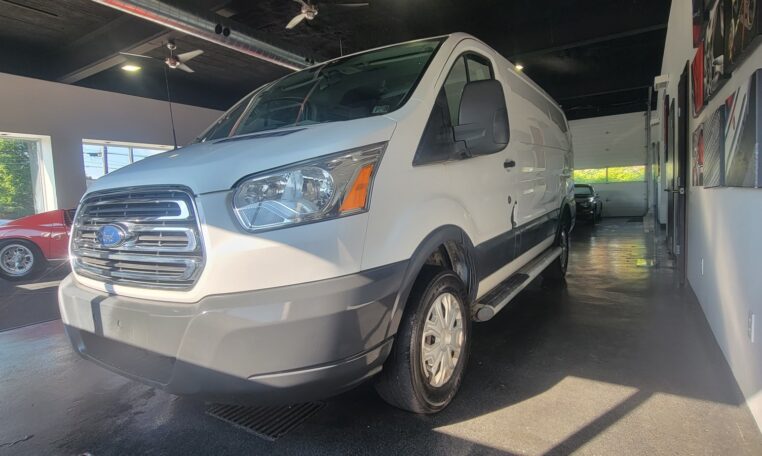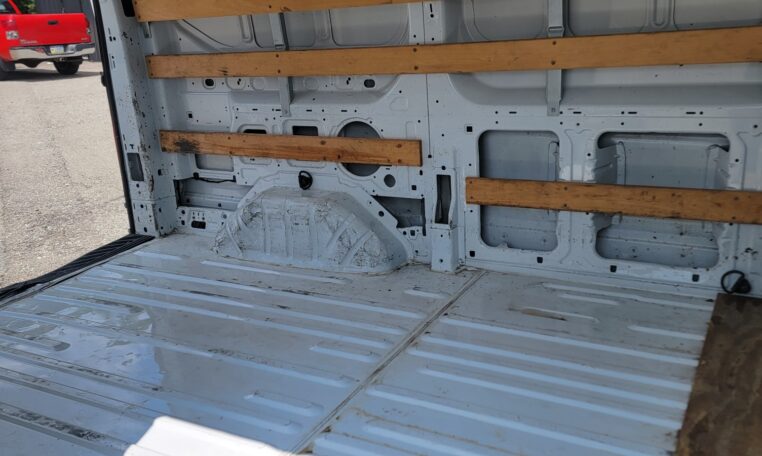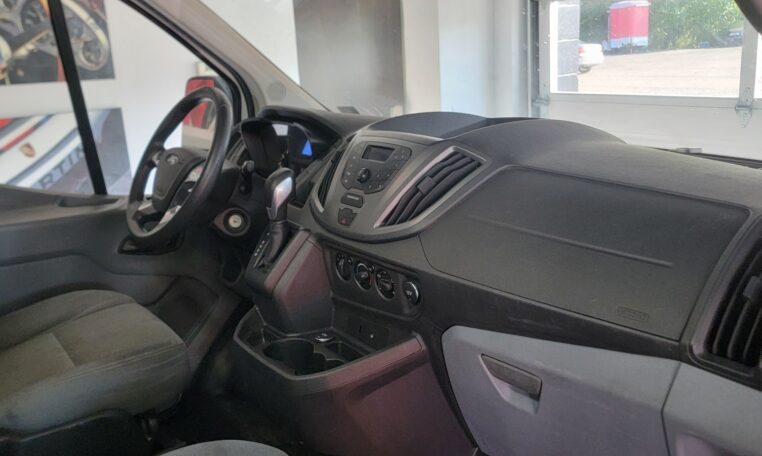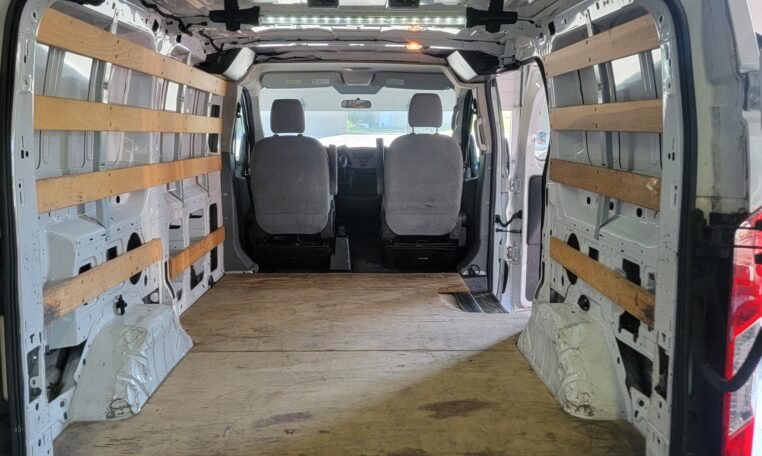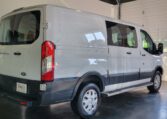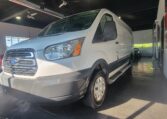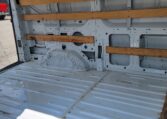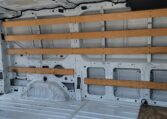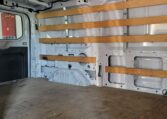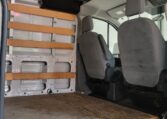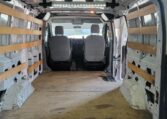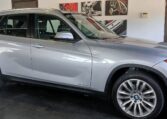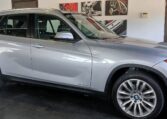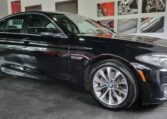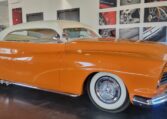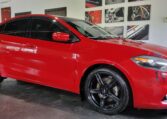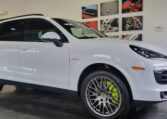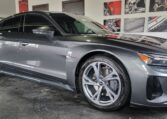Ford Transit 250 Cargo Van 2015
$21,995
$19,995
Plus Taxes & LicensingSoldFord Transit is a full-size van available as a passenger van or cargo van. Transit can be configured for a variety of specific uses and offers a choice of roof heights and overall lengths. Millions of them have been sold for decades around the world, but wasn’t introduced to the North American market until the 2014 model year. So it’s relatively new to us.
Transit is suitable for independent contractors, fleet operators, plus anyone who can use a small bus, including civic, school and public and private transportation entities. Larger models are big enough to take a few riders, dirt bikes and camping gear inside. They can serve as camping vehicles themselves.
Much like a pickup, Transit uses two wheelbases and three lengths and roof heights to make six wagon and fourteen cargo configurations. Wagon seating includes 8, 10, 12 or 15 seats with luggage space to match; maximum load ranges from 2300-3700 pounds and towing to 5100 pounds. Cargo van capacity peaks at 487 cubic feet by volume, payload is 3000-4600 pounds, and maximum tow rating is 7500 pounds.
All Transits have a six-speed automatic transmission and rear-wheel drive; like the Econoline, no factory 4WD system is offered. A 270-hp 3.7-liter V6 gasoline V6 is standard on all but dual-rear wheel models. A 3.5-liter turbocharged V6 is the performance choice with 310 hp and much more torque. The diesel choice is a 3.2-liter inline five-cylinder fuel-economy leader.
Transit rides like a tighter, more solid, better balanced 3/4-ton pickup and it can carry more than most pickups. Unlike a pickup, however, Transit does not have a separate frame and body assembly; it is a unit-body, like a car. Sensible 16-inch tires have plenty of sidewall to soften the impact from potholes and sharp road imperfections, and noise is well controlled. Despite its big footprint Transit is quite maneuverable.
All Transits look similar with nearly flat sides, tail and roof; if the mirrors fit through a gate or door the rest of it will too. Sliding or hinged right-side doors are offered, the barn doors in back open at least 180 degrees, and the huge windshield is easiest to clean standing on the front bumper’s built-in step. There are plenty of rack choices offered for the roof and the interior.
An upright driving position faces a broad dash, with many controls and gauges familiar to Ford car owners. The commercial background is apparent in bins and cupholders and most will appreciate the lack of a doghouse engine cover intruding on front seat room. Only a handbrake adjacent the driver’s seat has any effect on the walk-thru from front to back.
Wagon rear seating varies considerably by rows and aisles, but every seat has an individual backrest and built-in shoulder belt. The mounting brackets align longitudinally so long, slender items (10 feet back door to front belts on the shortest model) can be slid under the seat rows without removing any of them.
Transit competes against Mercedes-Benz Sprinter, Ram ProMaster, Nissan NV, Chevrolet Express and GMC Savana. To a lesser extent, Transit competes with the outgoing Ford Econoline van. Econoline is well proven but we can think of just two major advantages over the Transit: It has a higher top tow rating and it costs less.
LINEUP
Transit is offered in truck-like 150, 250 and 350 nomenclature (larger numbers mean more weight). The standard wheelbase Ford dubs medium is 130 inches, in 150 or 250 models. The longer 148-inch wheelbase (LWB) covers all three models, and offers an extended-length (EL) body on 250 and 350. Like trucks, HD DRW denotes heavy-duty dual-rear-wheel, and roof heights are low (LR is seven feet), medium (MR is 101 inches) and tall (HR is 110 inches). Cargo carriers are called Van, people carriers Wagon.
Transit 150 Van ($29,565) comes with a 3.7-liter V6 engine and six-speed automatic transmission. The 3.7 is available in a CNG fuel version. Standard equipment includes vinyl seats, climate control, tilt/telescoping steering wheel, power windows/door locks/mirrors, 50/50 180-degree opening rear doors, AM/FM stereo with aux input, 60/40 hinged right side doors, interior lighting front and rear, cargo tie-down rings, variable intermittent wipers, 16-inch steel wheels and full-size spare, remote keyless entry, cloth headliner and vinyl flooring.
MR and HR models have a sliding right side door (left optional). LWB model rear doors open 270 degrees. DRW models get the 3.5-liter turbo V6.
Cargo Van options include turbocharged gasoline and diesel engines, upholstery upgrades, power driver seat, interior and exterior upgrade packs, trailer wiring package that includes tow/haul mode and trailer sway control, rear window defrosters, Crew Chief by Telogis, rearview camera, tow package, integrated trailer-brake controller, backup alarm, and ambulance, RV and builder’s prep packages.
Transit Wagon XL ($32,100) offers similar equipment with the addition of all-row side curtain airbags, middle and third-row seats, six-speaker stereo, added power point, all-around fixed windows. Longer versions add more seating rows, front/rear climate control and flip-open fourth-row glass on LWB EL.
Transit Wagon XLT ($33,600) adds cloth upholstery, front/rear climate control, 8-speaker CD sound system and 4-inch multifunction display, cruise control and carpet throughout.
Wagon options include 3.5 and 3.2-liter engines, many cargo van packages, dual batteries, 110VAC outlet, Sync and My Fod Touch, SiriusXM and HD radio, MyKey, floor mats, lane departure warning, rear park sensors, privacy glass, flip-open second-row glass, Securicode keypad and perimeter alarm, running boards and aluminum wheels. Ford’s Crew Chief is offered on Vans (Wagons later) and uses a cell signal and GPS to provide an office/owner with vehicle and driver performance data, speed, idle time, diagnostic codes, service info and so forth.
Safety features include dual front, front side impact and all-row side curtain airbags, three-point belts in all seating positions, electronic stability/traction control and four-wheel anti-lock brakes. Options include a rearview camera and rear park sensors.
WALKAROUND
As with most vehicles designed to work Transit grafts a softened nose to a strictly rectangular body. If you can’t distinguish it from behind, don’t feel bad.
The nose uses a variation on Ford’s three-bar grille, chromed on some wagons, and headlights similar to other Ford product only swept back for airflow and front corner clearance. A plastic bumper minimizes scuffed paint, and the lower cooling duct can be used as a step for cleaning the windshield. Underhood serviceability is better than the Econoline.
Tall side mirrors have large standard and wide-angle elements, the former powered the latter manually adjusted. Despite their height the deep side window drop and high seating position mean most drivers look over them and they don’t present forward blind spots. Some mirrors are heated, some have signal repeaters. The fuel fill door abuts the driver’s door so no separate locking mechanism is needed, and the driver’s door can be shut while refueling to avoid stinking up or changing cabin climate.
Right side doors are 60/40 hinged on LR Vans, sliding on Wagons, MR and HR cargo vans; sliding left-side cargo door is expected. Side-door opening is minimum 51 inches wide and 49 (LR) or 63 (MR, HR) inches high. The Wagon’s side door, rear door and all-around windows are offered on Vans.
Vertical taillights allot similar area to brake/turn and backup lights, enough to use the camera or mirrors with some confidence at night. Rear doors split 50/50 and those with glass offer defrosters so the inside mirror is somewhat usable for more than monitoring passengers.
Rear doors open easily with stops parallel to the body sides or parallel to the rear bumper; on LWB models they open a further 270 degrees to park along the side panels. The rear camera is in the door and features a hash-line to indicate centerline for tow-ball hitching, while the park sensors are in the step bumper big enough for adult shoes.
Rear doors open nearly five feet wide, height matched to roof at 49.6, 62.8 or 72.2 inches. Minimum floor length is 116 inches, inside height 53 inches and only the dually is less than four feet wide between wheelhouses. Cargo van interior dimensions are generally a bit larger since they don’t have overhead ducting, insulation, wall panels and so on.
The Wagon has no obvious cargo area tie-down points though we suspect you could easily add some from the Van’s selection.
INTERIOR
Like its wrapper Transit’s interior stresses function with appropriate materials and useful spaces and electronics. But it isn’t a penalty box, as even lowly Vans can be equipped with power leather seats.
You step up twice, about 16 inches to the first and there are plenty of grab handles, to an upright driving position. Seats proved comfortable and easy to slide in and out of, adjustable inboard armrests guarding against fatigue. It’s easy to clamber in and out of with big boots on and the tilt/telescoping steering column stays out of the way. It’s range of adjustment in either direction is limited, so some longer-leg drivers will fin it most convenient to steer using only the bottom part of the wheel.
Any recent Ford driver will recognize controls, though you might not have seen some switchgear (park sensor, traction control, etc.) flanking the instruments. Steering wheel controls are numerous and the stalks logical, the lane departure warning switch is ideally placed on the end of the signal lever.
Blue-needle gauges and central display screen could have been lifted from a Focus or F-150 and convey necessary information. Beyond basic trip computer functions the display also handles towing data, driver assists and MyKey programming that could keep your kids, employees or volunteers better focused.
The shifter is handy on the dash, climate controls adjacent and overhead simple. Shorter drivers may find them and the center six-inch touch-screen a reach, and the small buttons’ On screen are hit-and-miss on less-than-smooth roads, so take advantage of the Sync MyFordTouch voice-recognition controls. Bluetooth pairing was simple, power and USB ports easy to get to.
Cab storage is quite good. A bin next to the shifter will hold a phone at a good angle for using it for navigation, pens and coins go in the center, and there’s cup or bottle stowage on top and knee-high on the dash edges, the doors and the center console. MR and HR models have ovearhead storage, some big enough for an umbrella.
Wagons use various permutations of 2, 3 and 4-occupant seat rows, and not all are the same size. In the smallest, eight-seat Wagon, the second row fits three but the third row also carries three and has a bit more width and legroom. Each position has independent limited recline, shoulder belt and headrest, and the second row has coat hooks on the headrests. Overhead and floor vents supply cooled or warmed air respectively.
This Wagon is rated at 95 cubic feet of cargo space behind the third row but it feels larger. Capacity behind the second row of seats is superior to an Odyssey, Sienna or Suburban with only the front seats in use. Second and third row seat stanchions are aligned so long, flat items are easily slid underneath, and the third row can be unlatched with three hands and lifted out with two people. The largest Transit Wagon carries fifteen in 2-3-3-3-4 configuration and still has 100 cubic feet of storage space behind.
Standard glass is fixed behind the front doors, but flip-open windows are available for some doors and rows whether cargo Van or Wagon. Most have roof lighting throughout.
Cargo van capacity ranges from 247 cubic feet in the smallest to 487 cubic feet in the largest with a 162-inch long load deck. Add 40-50 if the front passenger seat is removed.
DRIVING IMPRESSION
The Transit drives well, most like a full-size pickup with a really good view and excellent maneuverability.
Base power is a 3.7-liter V6 with 275 horsepower and 260 lb-ft of torque at 4000 rpm, a less-powerful version of what powered the F-150 pickup for years. With more power and less torque than Econoline’s 4.6-liter V8 it gets the job done by revving when power is needed. We’ve worked this engine in pickups running 6000 rpm up long grades with it never complaining, but you will hear it. Fortunately there is no engine intrusion into the front floor area as in Econoline so it’s quieter. It rates 14/19 EPA city/highway.
Standard on the biggest and optional on others is the 3.5-liter EcoBoost turbocharged V6. Here it rates just 35 more hp at 310 but torque is 400 lb-ft from 2250 rpm, outputs that compare to the Econoline’s 6.8-liter V10. The 3.5 delivers effortless performance and is surprisingly potent and delivers the same 14/19 EPA ratings. Our experience has shown EcoBoost an either/or proposition and using the power (boost) will use fuel. We averaged about 15.5 mpg, in town high 13s and pushing 20 on the highway, 90% of it with less than 15% load; in the previous 1200 miles with one-quarter running time at idle, it had done 14 mpg.
The 3.5 has a good exhaust note but the whistling from the turbochargers is near constant in anything but highway cruising. Both engines’ six-speed automatic works as it should and can be shifted manually to limit top gear or manually select any.
A 3.2-liter inline five-cylinder diesel engine is available on most configurations. It rates 185 hp and 350 lb-ft of torque from 1500 rpm, ranking it ahead of ProMaster’s big 3-liter four and Sprinter’s 3-liter V6 diesels. The diesel will cost the most up front, but owner-operators or fleets running lots of miles will appreciate fuel economy that should better the gas engines by 30% or more.
Ride quality improves with some load, no surprise in something rated to carry nearly 3000 pounds; an average for what most ?-ton heavy-duty pickups can manage. Unlike pickups, there’s no separate frame and body so there’s less motion and no shuddering over bumps, and the empty weight is better distributed. We expected wind noise from the big mirrors but didn’t get much, and most road noise comes from the rear tires on bad surfaces. Throwing the duffel bags over the wheel houses first helps.
Steering has good directional stability, even in a stuff crosswind or passing a truck or bus, and it turns tight for easier maneuverability than the average pickup or SUV this size. Squared corners and big mirrors make reversing into narrow confines easy even without the camera or sensors, and the view forward is excellent.
Maximum payload for Wagons ranges from 2610 to 3480 pounds, for Vans 3060-4560 pounds. Maximum tow ratings range from 2900-5100 and 4000-7600 pounds respectively, and the integrated trailer brake controller is recommended if your trailer has electric brakes. As with pickups, few Transit models (and by configuration/engine/axle ratio there are more than 130 iterations) will carry rated maximum payload and tow its heaviest trailer at the same time.
SUMMARY
The Transit is more space and fuel-efficient than the Econoline and offers plenty of configurations most competition can’t match. Whether you get it for carting large groups or people around, working out of it, or running a business with it, Transit’s inside that feels bigger than the outside should deliver.
- There are no features available
Browse through the selection of vehicles that have recently been added to our inventory.


